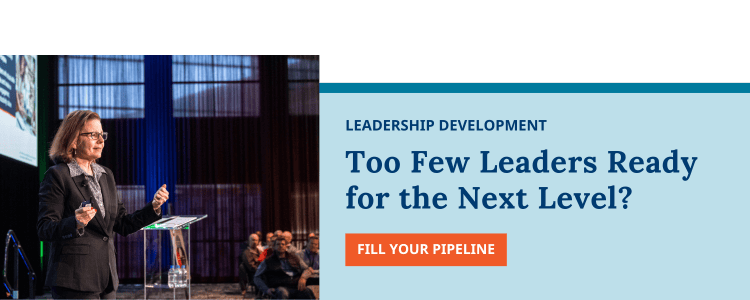Is your talent strategy keeping pace with today’s technology-driven, highly competitive business environment? A well-defined talent strategy isn’t just an option – it’s a necessity to address the talent shortage and to control business risks of poorly engineered tech deployments.
Your talent strategy is due for a refresh because the talent marketplace is vastly different from just a few years ago. Two factors are driving this makeover imperative.
- First: Talent has become scarcer and more empowered.
- Second: Large investments in powerful, digital technologies (including AI) will produce results on mass-scale. Organizations will need human-powered leadership to manage both positive and negative outcomes.
These colliding forces – scarcer, empowered talent and large-scale technology deployments – are the reasons that companies can no longer apply yesteryear’s talent strategies. Businesses that do not reimagine their talent strategy will pay the price.
New talent strategies emphasize investments in scalable leadership development. Employers will use learning opportunities on an unprecedented scale – to retain people who can lead others, collaborate globally, and harness the power of technology. Without effective retention and recruitment, organizations will end up overpaying for talent.
Market Force 1: Scarce Talent That’s Never Been More Empowered
How severe is the talent shortage? At the end of 2023, the US unemployment rate remained low at 3.7%. Benchmark that with the fact that most economists consider anything below 5% to be “full employment.” Baby Boomers’ retirement has been a big factor. Overall, scarce talent has produced an array of changes in the workplace.

When Boomers were in their 30s and 40s, long hours and long commutes were typical for most people. This included white-collared, salaried workers. Many people had no paid vacation or worked a full year before earning one. Mothers who were offered “maternity leave” were often shamed for taking four to six weeks off – and those leaves were often unpaid. Employees who wanted a more family-friendly lifestyle remained reticent while louder voices heralded the stereotypical workaholic and road warriors.
Shorter Hours
Today white-collared, salaried workers are often stymied by the suggestion that they work more than 40 hours in a week. In July 2023, Rep. Mark Takano introduced legislation to institute a 32-hour week for Californians. Other states including Hawaii, Maryland, New York, Pennsylvania, and Washington expressed interest after the UK reported successful trials of a shorter workweek.
Less Commuting
Many of today’s employees refuse to commute to an office – or at least not commute more than two or three days a week. Economists Jose Maria Barrero, Nicholas Bloom, Shelby Buckman, and Steven Davis, who have studied remote work, say it peaked during the Pandemic at 60% of total workdays. It is now about 29.4% of workdays. They expect this level to hold steady and not go back to what was once “normal.”
Paid Parental Leave
While the US lags other developed countries in providing paid parental leave – especially for fathers – this benefit is gaining popularity for both parents today because of the tight talent market. About 9% of America’s largest companies provide parity parental leave. Disclosure of a paid parental leave policy is increasing. As of September 2022, 60% of America’s largest public companies disclosed a paid parental leave policy, compared to 47% the year before.
Shorter work weeks, remote work, parental leave…are these new ideas? Of course not.
Employees are exerting more power today than they did in previous decades, when the talent supply was larger. Today’s more worker-friendly policies have less to do with enlightenment and more to do with supply and demand, according to economic experts. Because of shrinking supply, The Economist calls today’s talent market in developed countries “the golden age” for workers.
“As societies age, labor is becoming scarcer and better rewarded, especially manual work that is hard to replace with technology,” says The Economist Nov 2023 issue. “Governments are spending big and running economies hot, supporting demands for higher wages. They are likely to continue to do so. AI is giving workers, particularly less skilled ones, a productivity boost, which could lead to higher wages, too.”

Market Force 2: Powerful Digital & AI Transformations Require Steady Leadership
IDC and Statista say that global digital transformation spending – which was about $2trn in 2023 – will increase by a massive 57% and hit $3.4trn worldwide by 2026. That’s up from $1.18trn in 2019.
According to HBR, “While 89% of large companies globally have a digital and AI transformation underway, they have only captured 31% of the expected revenue lift and 25% of expected cost savings from the effort.”
What else can go wrong? Failed technology deployments can cause business interruptions, lost brand value, declining market share, and other unforeseen consequences – including “AI hallucinations” that jeopardize business results and reputation.
Experts at IBM describe an AI hallucination as “a phenomenon wherein a large language model (LLM) perceives patterns or objects that are nonexistent or imperceptible to human observers.”
How Can Companies De-Risk Massive Investments in Tech?
“One way to de-risk huge capital investments in digital transformation is through regular investment in leadership development,” advises Lauren Herring, CEO of IMPACT Group.
“Human-powered leadership – involving discernment, ethics, and circumspection – is required to expertly unleash the power of digital and AI deployments. In addition to technical skills, businesses will need leaders with soft skills to collaborate with multidisciplinary teams. This will ensure they deliver ROI from these enormous investments.”
Today’s high-tech environment will offer tremendous opportunity. But these advances will require leadership from well-prepared, highly skilled leaders to guide these deployments.
3 Essential Elements for Today’s Talent Strategy
Organizations must double down on the benefits and cultural norms that promote employee retention. Compensation is key. Employers have increased compensation in recent years to attract and retain talent. But employers don’t want to set off an arms race by relying on higher wages alone. Employers need a broader set of tactics, which are listed below:
1. Leadership & Professional Development
One of the most common perks to get people to stay is by offering various types of upskilling, including soft skills development. The data is clear. The No. 1 way organizations are working to improve retention is by providing learning opportunities. This is according to the 2023 Workplace Learning Report.
2. Online LD Programs that Scale to Larger Populations of Leaders
Based on the above research, if you’re only developing a small percentage of your workforce, you can expect to retain only a few. That’s why organizations are using cost-effective, online learning platforms. Rising talent want to learn leadership and management skills, among other soft skills. Online platforms, such as LinkedIn Learning, allow organizations to scale these offerings for greater impact.
3. Microcoaching to Support Engagement in Online Platforms
Online learning is a great way to offer microlearning – in easily consumable “chunks.” However, the drawback of online learning has been one of engagement. It’s difficult to sustain participation. One way to boost engagement and learning hours is to combine online learning with a leadership coach. Coaches help learners stay engaged and apply what they’ve learned. Cost-effective programs, like microcoaching, might pair an online learner with a coach for 2 to 3 short sessions per course.

Summary: Refresh Your Talent Strategy with Scalable, Online Microlearning & Microcoaching
Economists agree that retention is not just about compensation. “Rules of supply and demand in a free-market and labor-mobile economy suggest that things will eventually even out: those companies that treat their workers well generally have better retention rates, even when the pay they offer is not top-of-industry. Those workers who job hop for salary or for other reasons will eventually either find a fit or enough to make do,” Wittman said.
The integration of online platforms such as LinkedIn Learning with personalized coaching is set to become a mainstream trend. It not only makes learning more engaging, but also enables the creation of tailored action plans. This maximizes individual growth and organizational performance.
This dual approach ensures that employees are not just learning but also applying new skills in a way that contributes to the organization’s goals. IMPACT Group’s survey of talent leaders on corporate online learning found that 84% believe that online learners are more likely to put new skills to use if they also work with a coach who encourages behavior change.
As you contemplate a talent strategy refresh, consider how you might add microcoaching to your online learning program.
By investing in such a strategy, companies can ensure that they are not only developing the leaders of the future, but also bolstering their retention and overall organizational health.
Link Learn Coach allows you to do just that. This program is specifically designed to improve online learning engagement and satisfaction so you achieve a higher ROI. Learn more about this program for frontline managers and other leaders today.